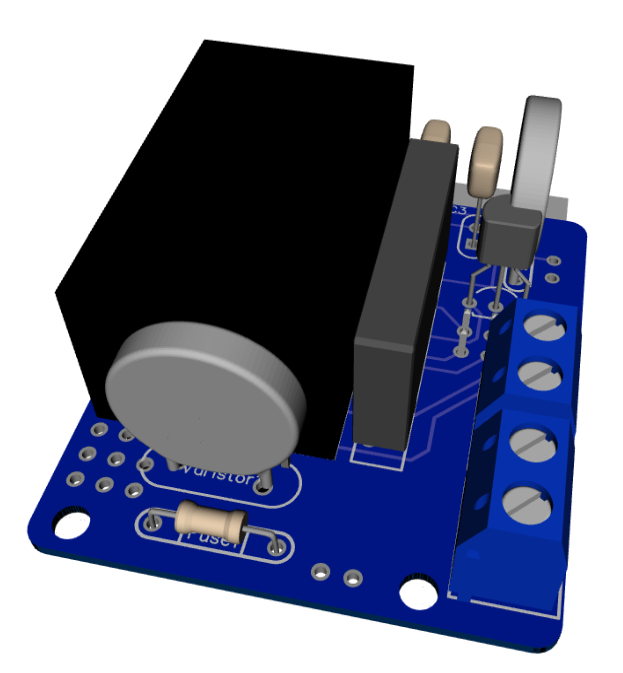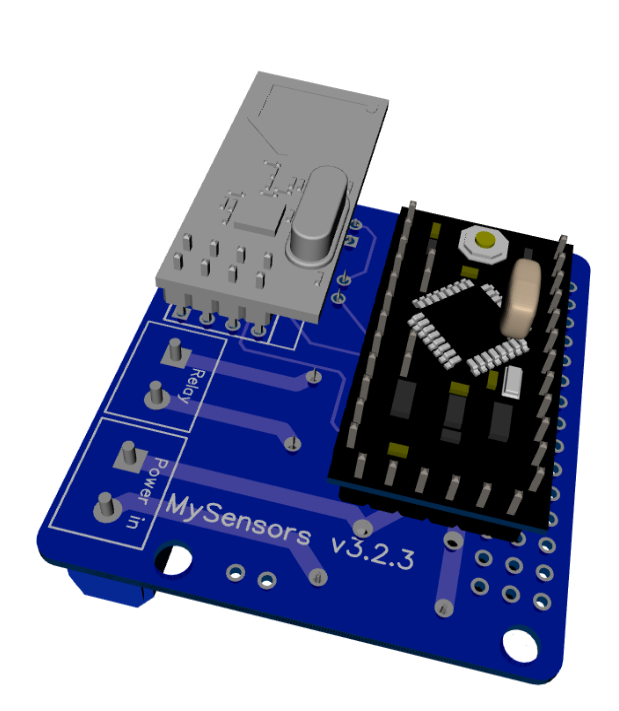110v-230v AC to Mysensors PCB board
-
As promised, I've got an update for this project. The board has been tested in the past week, and everything is working as expected. Compared to the previous board I've posted, I have updated the following:
• Solder pads of LE33CZ have been placed a little wider apart to avoid short circuit while soldering.
• Solder pads of the resettable fuse (Fuse2) has been placed closer together to better fit the fuses of the BOM.
• Moved the NRF24L01 connector a bit away from the solid state relay. Should make it easier to solder.
• Moved Fuse2 to another location on the board, away from the 230v circuit.Some 3D pictures (Top and bottom):


Anyone who is interested can order the PCB HERE
Some documentation, and all gerber / DipTrace files (in case you would like to make some modifications) can be found here: MySensors board v3.2.3.zip.
@aproxx hello. can i know how you rendered your PCB layout to 3D , if any tutorial it can guide me
to achieve that .thanks
-
Wow, this thread has been really active in the past few months! I'm sorry for my absence, but I kind of got dragged into other projects.. :)
A new version of the board will be shared soon! Compared to the current board following changes have been made:
- A second solid state relay has been added. This 2nd relay is optional, so if only 1 device needs to be controlled just 1 relay needs to be installed and everything will still work fine.
- The board size has been increased just a little bit to fit this 2nd relay. Size is still 5x5cm only.
- Some components have been moved in order to make it easier to solder them (This was a bit tricky on version 3.2.3 because some components were really close to each other).
- Traces between the relays and the connectors are now 'open air'. So there is no mask on top of the traces. This way it is possible to reinforce the traces. By doing this it shouldn't be any problem to connect a 2A load to the board.
- A temperature cut-off has been added to the board.
- The varistor for the low voltage circuit has been removed because it's not really needed anymore with all the extra security measures on the high voltage side of the board.
Currently this board is still on it's way from China, but as soon as I've received this board I'll share all the documentation and everything else which is needed on this forum! This will probably happen in 3-5 weeks from now, so stay tuned! ;)
-
Wow, this thread has been really active in the past few months! I'm sorry for my absence, but I kind of got dragged into other projects.. :)
A new version of the board will be shared soon! Compared to the current board following changes have been made:
- A second solid state relay has been added. This 2nd relay is optional, so if only 1 device needs to be controlled just 1 relay needs to be installed and everything will still work fine.
- The board size has been increased just a little bit to fit this 2nd relay. Size is still 5x5cm only.
- Some components have been moved in order to make it easier to solder them (This was a bit tricky on version 3.2.3 because some components were really close to each other).
- Traces between the relays and the connectors are now 'open air'. So there is no mask on top of the traces. This way it is possible to reinforce the traces. By doing this it shouldn't be any problem to connect a 2A load to the board.
- A temperature cut-off has been added to the board.
- The varistor for the low voltage circuit has been removed because it's not really needed anymore with all the extra security measures on the high voltage side of the board.
Currently this board is still on it's way from China, but as soon as I've received this board I'll share all the documentation and everything else which is needed on this forum! This will probably happen in 3-5 weeks from now, so stay tuned! ;)
-
bad news :-/ then why have you fuse at home ? 400 000 V has security measures, why add more security ? it's juste our life, childs life !!
do you know what is a "security transformer" ? the hlk-pm01 isn't one. -
bad news :-/ then why have you fuse at home ? 400 000 V has security measures, why add more security ? it's juste our life, childs life !!
do you know what is a "security transformer" ? the hlk-pm01 isn't one.@vil1driver said:
bad news :-/ then why have you fuse at home ? 400 000 V has security measures, why add more security ? it's juste our life, childs life !!
do you know what is a "security transformer" ? the hlk-pm01 isn't one.It's not that I think that security isn't important, but I believe that no security on the low voltage side is safer than having a false sense of security. As I've read above, lots of the low voltage fuses were not reliable. And that's one reason I dropped it in the newer design.
All that aside: I never ever EVER intend to mount these boards on locations people can reach (unless they intend to). Everything is placed safely behind a light switch or in a completely closed plastic box. The only thing that COULD be touched is the wires to the switch itself (And even those will be out of reach if the lid of the switch is on). But since these switches are only connected to ground and a digital input, those wires don't do any harm.
But yes, I do know what a 'security transformer' is. And no, I completely agree the HLK-PM01 itself isn't a secure transformer. But considering the price, the added fuses and temp cutoffs, and the plan to mount these in a safe location, I believe the HLK-PM01 does the job well. ;)
-
thanks for your answer,
-
Secure? ... A varistor and a 8v fuse on secundary line! ...
Never touch devices when powered to mains. A simple light bulb that you can touch on metal part, a tablet charger that can blow up... just don't touch the module and put it inside wall (not wood) or circuit case. -
Wow, this thread has been really active in the past few months! I'm sorry for my absence, but I kind of got dragged into other projects.. :)
A new version of the board will be shared soon! Compared to the current board following changes have been made:
- A second solid state relay has been added. This 2nd relay is optional, so if only 1 device needs to be controlled just 1 relay needs to be installed and everything will still work fine.
- The board size has been increased just a little bit to fit this 2nd relay. Size is still 5x5cm only.
- Some components have been moved in order to make it easier to solder them (This was a bit tricky on version 3.2.3 because some components were really close to each other).
- Traces between the relays and the connectors are now 'open air'. So there is no mask on top of the traces. This way it is possible to reinforce the traces. By doing this it shouldn't be any problem to connect a 2A load to the board.
- A temperature cut-off has been added to the board.
- The varistor for the low voltage circuit has been removed because it's not really needed anymore with all the extra security measures on the high voltage side of the board.
Currently this board is still on it's way from China, but as soon as I've received this board I'll share all the documentation and everything else which is needed on this forum! This will probably happen in 3-5 weeks from now, so stay tuned! ;)
-
@jemish The boards were sent to me from China 5 days ago. I don't have a tracking number available, but usually it takes between 3 and 5 weeks before they reach me (Belgium). I already have all the necessary components, so within a week after I received the boards I'll provide this topic with an update.
-
Its been a long time since I built one of these but I recall there were some gotchas. I have a bunch of version 2.2.3. Besides the silk screen showing wrong orientation for the regulator what else was there?
Perhaps @aproxx could update first post?
Thanks! -
Hi @shabba.
I assume you mean version 3.2.3 of the board?
Besides the silkscreen of the LE33 being the other way around, there are a few other things to keep in mind:- The drill holes of the fuse/varistor on the 230v side might be a bit small. So it is advised to either make those holes a bit bigger, or to make the legs of the fuse/varistor a bit thinner using some sandpaper.
- Make sure to solder the components in the correct order (As mentioned in the Word document, which is part of the ZIP file of the opening post).
I'll update the first post of this topic in a few weeks, which includes the newer board version that fixes all the problems as stated above.
-
Hi @shabba.
I assume you mean version 3.2.3 of the board?
Besides the silkscreen of the LE33 being the other way around, there are a few other things to keep in mind:- The drill holes of the fuse/varistor on the 230v side might be a bit small. So it is advised to either make those holes a bit bigger, or to make the legs of the fuse/varistor a bit thinner using some sandpaper.
- Make sure to solder the components in the correct order (As mentioned in the Word document, which is part of the ZIP file of the opening post).
I'll update the first post of this topic in a few weeks, which includes the newer board version that fixes all the problems as stated above.
-
Ordered the boards... Can't wait!
Ever thought of implementing ACS 712 ?
-
@jemish
Then your wait is almost over! :) I'm currently doing my latest tests on the board, and so far everything works perfectly. I'll try and see if I can post everything during next weekend.@aproxx great news! This is something I look forward to!
-
@aproxx will the second relay be opt-in?
I mean, will the board function normally with only one relay? -
@aproxx will the second relay be opt-in?
I mean, will the board function normally with only one relay?@Sefi-Ninio
Yes, it will be perfectly possible to just install 1 relay on the board and it will still work fine.
More news in the next few days! ;)
